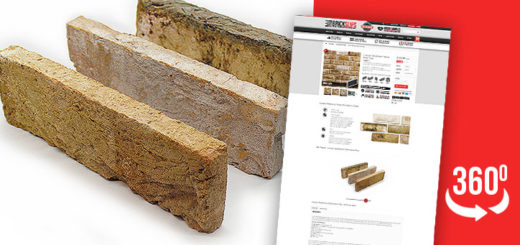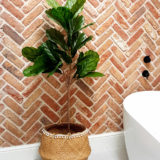Brick slips are a quick and cost-effective material for finishing the exterior of your home, or even a modern look interior without the hassle of having a wall constructed. If you are looking for an ultra-fast way to disguise a new home, or updating the exterior of an existing house, then brick slips might be the answer for you!
These brick slices of masonry replicate the appearance of conventional bricks, and can be delivered in a variety of styles and colors for a contemporary and traditional look.
What makes up a brick slip?
The thin strip of material forming a slip is manufactured in one of two ways in general. The first is simply a modification of the process for conventional bricks, which makes for a cost effective product. Extruded clay is run down a production line where a wire section is cut and then fired before it’s slimline profile is baked in the usual brick production process.
This type is sometimes referred to as “preformed” or “manufactured” slips. We shy away from this as we do not believe that the end product is as realistic as other real clay methods…
As mentioned, the other option is that the brick slips can also be cut from the face of standard clay bricks. When produced this traditional option which are sometimes known as real brick slips are the better and more authentic method of brick slip cladding. This method may be useful if you want to tailor-made units, for example, if the brick needs to vary in the thickness, or if you want a case that has been carved out of handmade masonry. The disadvantage is that you pay a lot more for the bespoke privilege however the look and feel is genuine and something that you will always be able to add the “bespoke” tag against.

Slips are designed to replicate the appearance of real masonry work. Most brick slips are made up of conventional metric dimensions (215mm wide and 65mm high) which fit perfectly again previous real brick installs – although many vendors can take special order sizes.
Standard thicknesses for slips are 15mm, 20mm, 25mm, 30mm, 40mm and 50mm vary but only depending on the manufacturer or brick type. Corner slips or Pistol slips are to create a seamless tote-bond effect, and other bespoke ranges such as header slips and stretcher reveals are also used to complete the perfect genuine look of your brick slip project.
All our Brick Slips are cut from the finest bricks available, all our brick slips are manufactured to the stringent BSEN 771–1classificationwhich is the European standard for clay masonry units, and gives you the confidence that our Brick Slips really are the market leaders.
How do brick slips work?
Our brick slips are delivered as single units to be assembled on site. The process is reminiscent of tiles: horizontal lines are set to help positioning;
A special rapid set adhesive is then (in manageable pieces or on the back of each tile, in accordance with the manufacturer’s instructions to the substrate either) is applied and the brick slips are finally set in place, you’d typically start with corners or at a clean edge.
 Depending on the system, you must manually measure the grout lines with spacer units. Spacers can be set in any size however the standard brick spacing used is 10mm. We sell spacers in packs of 200 which are the perfect size to keep your installation looking consistant.
Depending on the system, you must manually measure the grout lines with spacer units. Spacers can be set in any size however the standard brick spacing used is 10mm. We sell spacers in packs of 200 which are the perfect size to keep your installation looking consistant.
You can also buy facade panels that are already decorated with brick finish. Interlocking prefabricated panels are also available, which ensures an exact alignment. The manufacturing process provides an additional level of quality control however we don’t currently offer these on a small scale but should your project require we can speak to you about your needs and requirements.
Insulated brick slip cladding
One of the most common uses of slips is as a finish for exterior wall insulation. As with conventional slips, either the units are connected to the substrate (in this case, rigid insulation panels that have been mechanically secured to the wall) delivered on site or as a pre-insulated cladding panels. Both options are fantastic for retrofitting existing solid wall to reach homes modern standards of energy efficiency, while maintaining a traditional brick facade.
This system is also suitable for new buildings, especially where a masonry finish for desired construction looks, such as wood frames, insulating concrete form, solid wall and structural insulated panels. This can also give you the opportunity to reduce wall thickness compared to traditional brick and block so it is possible to gain valuable internal space. Bonus!
What will it cost?
Prices from around £10 per 1/2 m2 for the basic of brick slips. You usually need about 60 tiles per m2 – which is comparable to the normal brick. However, the exact cost on the slip that are using you and the type of brick is specified, handmade or specialty products often carry a high price, for example our highly popular Camden brick slips has a much better looking texture but comes with a slightly higher price tag. You will also need to allow for insulation, adhesives and specialist bed when pricing up the project.
Up-front costs will be higher than for conventional brick, but you can save costs that are used through labor. Even better though is the brick slips are easy to install and the structure may require less support for something a 10th of the weight of real brick – So that means you can save cash on these steps and pull more money into other fundamental stages of your build.
About BrickSlips.co.uk
All of our products are manufactured on site using the latest brick cutting technology to ensure our Brick Slips are of the very best quality, once they have been cut they then go through a stringent two stage quality control process. For more information on what we can do to help your project or business need, speak to one of our team on 0844 567 8811 or email use direct at sales@brickslips.co.uk and we’ll be more than happy to assist.































Morning. Is it possible to fit the brick slips on an external rendered wall painted with masonry paint. The paint is solid and not flaking at all
Hi Martin, yes this is possible, just be aware though that if the substrate layer of bricks is uneven, this will replicate to your brick slips. So we do recommend a render or external ply layer as the substrate for such application.
Hi there,
Please can you advise if the slips are suitable for a interior plastered dry wall?